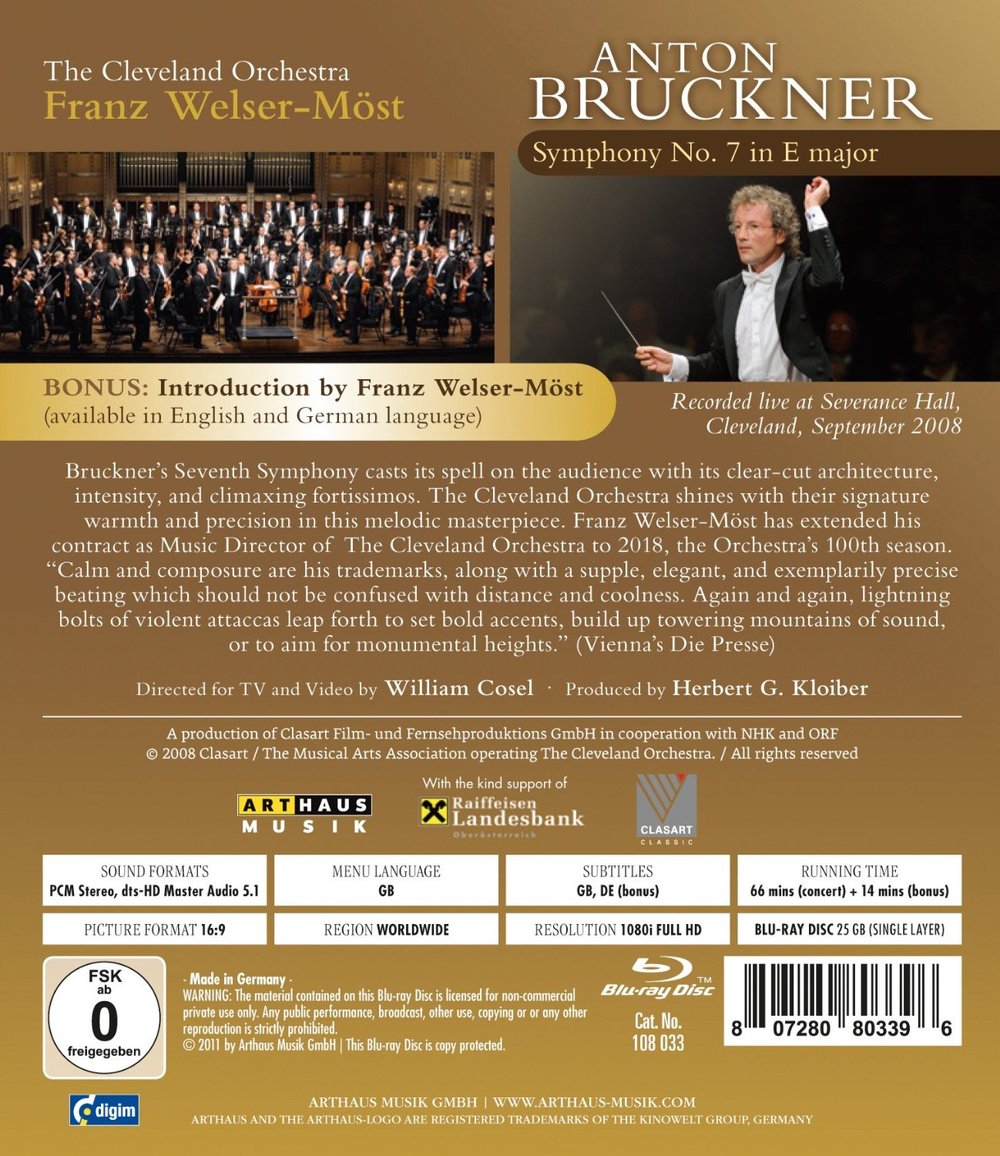

Bruckner Symphony No. 7. Franz Welser-Möst conducts the Cleveland Orchestra at Severance Hall in 2008. Directed for TV by William Cosel. This title, originating with Clasart Film und Fernsehproduktions GmbH, was produced by Herbert G. Kloiber. Released 2011, disc has 5.1 dts-HD Master Audio sound. Grade: D
I have no doubt this was a decent performance or better. But the recording little going for it.
The video has a bad case of DVDitis and is full of technical and artistic errors. DVDitis is a disease that is caused by trying to turn a DVD into an HDVD by publishing it in 1080 video. Read here why the same video of a symphony can't be both a good DVD and a good HDVD.
PQ is also weak. I reviewed this disc in 2011 on entry-level gear, in 2015 on newer mid-level gear, and in 2016 in John Fort's reference HT showroom in Dallas, Texas. I found the disc unwatchable in 2011 on entry-level gear because of gross pixalization of images, wavering straight lines, poor color balance, and the like. The disc looked some better in 2015 in my improved HT. In John Fort's showroom, the video was still not great, but distinctly better than what I had seen before.
Now let's discuss the DVDitis and PQ in more detail with screenshots. The most common symptom of DVDitis is a fast pace of video cuts. I count 518 cuts for subject title in 66 minutes of music, which works out to an average of 7.6 seconds per cut. A good HDVD tends to have an average cut duration of about 15 seconds or more, so this Bruckner 7 is about twice as hectic as it should be.
A good symphony HDVD always has many large-scale views of the whole orchestra and large parts of the orchestra. This Bruckner 7 has 13 attempts at a whole-orchestra shot, but they are all useless. The view in our first screenshot below occurs 11 times in the video. It's not really a whole-orchestra picture since the orchestra only fills about 1/6 of the screen. And when you try to see who is sitting where with which instruments, you can hardly make out anything because the image is filled with "blocking" and other "video noise." (In the DVD, this picture was intended to be an "architectural shot" commenting on the magnificence of building, not the band.)
Next below is one of two valid whole-orchestra shots in the video. But the resolution is still miserable. Can you count the number of cello or double-bass players? Can you distinguish any of the winds?
There are exactly 3 part-orchestra shots in the video, and below is the nicest of these. Now you can at least tell who is playing what. But would you really enjoy video this poor?
There are a number of shots of details of the ornate building. When I first viewed this title in my original home theater, the straight lines in those images would jump around. After upgrading my Blu-ray player and AVR, there are fewer such video artifacts. But look at the organ pipes in the view below. Even today my display can't make a stable image of these pipes:
Another hallmark of DVDitis is too many lazy conductor views. This video has more conductor clips (124 or 24% of the total of 518) than any other class of image. This means 1/4 of your purchase price for this is spent on watching Welser-Möst, who is one of the calmest, least-demonstrative, most modest, and boring of the conductors to watch. (This is not intended to be critical of Welser-Möst's talent as a conductor---he didn't sign on to be a movie star). Once again, poor resolution is seen in the conductor's face and the blurred sheet music before the players:
There are no less than 41 of the detested "conductor-over-backs" shots. Views like the next two below are insulting to the wonderful musicians of the Cleveland Orchestra. Their union ought to ask for an injunction:
The majority of the shots in the video are seemingly endless short clips of solos or small groups of musicians. I picked the next two views at random. In the image of the cello player below, the cello strings are not solid on the display in my HT---the straight lines dissolve into a string of "jaggies" that look a bit like tiny beads held together by an invisible thread:
Next is a random view of several 1st violins. Obviously the violins are playing, but there is nothing from the music to relate to this group. Rather than show the violins as a section, the TV director gives us this tiny segment. Most of the isolated views such as this are also accompanied with constant panning around or zooming in and out. The image below on my calibrated display tends to make the faces of the players look odd. After consulted my HQV Image Quality Assessment Tool (HD HQV Benchmark), I'll make a guess that someone tried to use what are called "spatial noise filters" to reduce video noise, and that's why the players often appear to have plastic skin (in various shades of yellow, pink, and gray). Believe it or not, the PC image below looks better than what I see in my HT and it is similar to the images I saw of this in John Fort's elite showroom:
As seen in the next two shots, there are many problems with lack of depth-of-field-of-focus. In the first image, there are 6 violins, but only one is in focus.
And here are maybe 8 or 9 players with only one in focus:
Next below the field-of-focus is much better, but the image is an ugly jumble:
The videographer was working in the orchestra's home venue and had plenty of light and room to locate cameras correctly to get well-framed views with good focus. The next view could have been promising, but the camera is at a poor angle and the tuba winds up ruining the effort:
Another hallmark of DVDitis is the use of "instrument only" shots as lazy filler. Our Bruckner 7 has 21 of these. The one I show below is both inane and completely out-of-focus:
Finally, I have to comment on the music recording. The sound was not recorded using 96kHz/24 bit sampling technology, which should be the starting point for fine symphony recordings destined to be published Blu-ray form. If you accept 48kHz/24-bit sound sampling (as many experts do), the sound recording is decent. I do not in the recording hear a pleasant combination of all the sections playing as part of an entity. I hear different sections and groups of instruments rotating through pushing the others aside. The reeds and brass are the dominant tribes. The strings labor in servitude with the double-basses abandoned in the mixing room. There are perhaps 8 instances in the video where you see a tympani solo but can't hear much from the kettles at all.
There is only 1 hour and 6 minutes of music on the disc. This might be a reasonable value on an LP or CD, but it's a poor value with a Blu-ray disc (that can hold 4 hours of music).
This is among the weaker classical music Blu-rays to be released. If you have older or entry-level playing gear, I suggest you pass on this. If you have mid-level gear in your HT, this would be a D title — buy it only if you have a real good reason. If you have reference-level gear, you could call this a "C" title, i.e., one that gets faint praise at best.
OR














